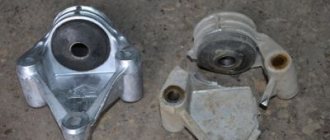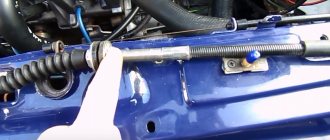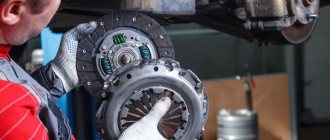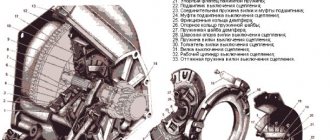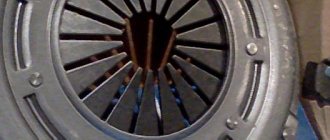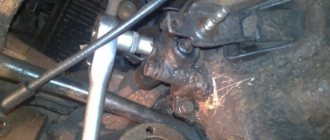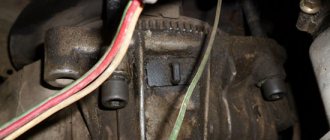Cars of the 09 VAZ family are equipped with a cable-operated clutch. This technology is 5 times more reliable than classic variations with hydraulic drive. However, during operation, any mechanism requires calibration and this unit is no exception. A scheduled inspection must be performed every 15,000 km or once a year, whichever comes first. However, unexpected breakdowns occur that require surgical intervention.
The following factors are considered signs of incorrect operation of the unit.
- The car starts moving jerkily - the clutch slips, which causes uneven acceleration.
- Increase in fuel consumption by approximately 10-15%.
- Dissonance between engine speed and actual acceleration of the car.
- When shifting into gear, extraneous sounds and squeaks are heard from the gearbox.
- When inspecting the car, there is an unpleasant smell of burnt pads.
- The pedal falls or sticks.
- The drive does not operate in the middle of the pedal stroke.
If even 1 of the listed points is detected, the design must be adjusted.
Why do you need clutch adjustment?
Adjustment is necessary due to normal wear and tear. Between the basket and the disc there are friction linings that are subject to abrasion. Consequently, after grinding them down, the pedal rises and the unit acts up.
The second reason is stretching of the clutch cable. As its length increases, similar defects occur.
Incomplete disengagement of the clutch (clutch “drives”)
With this malfunction, it is difficult to change forward gears, and reverse gear is engaged with noise. Causes of the malfunction and ways to eliminate it:
- large free play of the clutch release fork lever due to an increase in the gap between the clutch release bearing and the petals of the pressure spring (for a clutch with a servo mechanism). This leads to an increase in the free play of the clutch pedal (clutch release lever) and a decrease in the working stroke. Therefore, complete separation of the clutch discs does not occur. This cause of the malfunction can be eliminated by adjusting the free play of the clutch release fork lever, as indicated above;
- warping of disks. This malfunction occurs when the clutch discs overheat due to their slipping. The end runout of the driven disk should not exceed 0.5 mm. If the runout is greater, the disc should be straightened or replaced. If the pressure plate becomes warped, it is replaced as an assembly with the clutch casing and pressure spring;
- jamming of the driven disk hub on the splines of the input shaft. This malfunction may occur after prolonged or improper use of the vehicle due to contamination or wear of the splines. In the first case, it is enough to clean the shaft and hub splines and coat them with LSC-15 or Litol-24 grease; in the second case, replace worn parts;
- loosening of rivets or breakage of friction linings. It is necessary to rivet the friction linings using steel rivets. After flaring, the rivets should not have any breaks. The distance from the rivet to the surface of the friction lining must be at least 0.2 mm;
- insufficient clutch pedal travel. This malfunction occurs due to incorrect adjustment of the backlash-free drive when the pedal travel is not enough to completely disengage the clutch discs. To eliminate the malfunction, you need to correctly adjust the pedal travel within 125–130 mm;
- malfunction of the clutch cable due to damage to the cable or its sheath or other reasons causing the clutch drive to jam. It is necessary to determine the cause of the malfunction and replace damaged or worn parts.
Clutch operation diagnostics
To understand whether the clutch is working correctly, just follow the procedure.
- Take a ruler and place it on the floor. The other end of the meter should be attached to the bottom of the pedal. It should be approximately 18-19 centimeters.
- Press the lever all the way and measure the distance again - normally it will be 7-8 cm.
- It is considered normal when the difference between the readings is 13.5-14.5 cm.
If there is a deviation in the parameters from the norm by more than 20 mm, the drive needs to be adjusted.
Nine clutch device
The clutch kit is one of the key components of the Nine transmission. This is a single-disc friction-type mechanism located between the engine and the gearbox (gearbox). The algorithm for its operation is as follows:
- Initially, the car is stationary, the engine is started, the pedal is released. The gearshift lever is in the neutral position, that is, the rotation of the input shaft is not transmitted to the secondary shaft.
- The driver is preparing to move forward. With his left foot he presses the pedal, and the mechanism disconnects the gearbox input shaft from the engine. The driver moves the lever to the first gear position, the mechanism ensures the engagement of the primary and secondary shafts of the gearbox. The car is stationary because the engine is disconnected from the transmission input shaft.
- The driver smoothly but decisively releases the pedal. The engine is connected to the input shaft, the task of which is to transmit power to the drive wheels through the secondary shaft, then the car will start moving.
- Switching from first gear to second, from second to third, and so on occurs in the same way.
The VAZ 2109 clutch design is such that when the pedal is released, the driven disk is clamped by springs between the flywheel and the pressure plate. In this case, power is transferred to both gearbox shafts and the drive wheels. When you press the pedal, the VAZ 2109 clutch fork rotates through a special rod and presses on the levers that retract the pressure plate. The VAZ 2109 clutch driven disc is disconnected and power transmission stops. The mechanism casing is connected to the pressure plate by three pairs of elastic plates. The unit is driven by a cable, its lower tip is fixed with nuts in a bracket on the engine crankcase.
The clutch cable is connected to the clutch release fork lever.
Replacing the clutch cable on a VAZ 2109
Installing a new part is easy. There is only primitive mechanics here, based on the transfer of energy through a cable.
Reasons for replacement
The reason for repair may be clutch slipping or difficulty shifting gears. It often happens that the cable breaks due to a sudden load or jerk - this becomes the main source of problems.
Replacement
Performed in 2 ways. You will need a simple set of tools and 30 minutes of personal time.
Taking off the frill
A complex procedure involves many unnecessary steps, but if there is a question, there will be an answer.
- Drive the car into the inspection hole.
- Unscrew the cable from the pedal and remove it.
- Next, remove the frill and windshield wiper and open the hood.
- Then you should find the place where the cable is attached to the car. Unscrew it.
- Remove the old line and install a new one in its place.
Without removing the frill
You can replace the cable at home like this.
- Remove the adjusting part from the mount on the gearbox housing.
- Unscrew the cable guide and disconnect it from the clutch fork.
- The end of the cable is disconnected from the pedal by removing the cotter pin.
- Next, the entire line is pulled out of the car.
- Installing a new line is performed in the reverse order.
Reasons for replacement
Practice shows that there are several main situations that force you to change the clutch cable.
| Situation | Peculiarities |
| The clutch does not work properly | It becomes difficult for the driver to depress the clutch pedal, which causes problems when trying to move away or start the car, the clutch slips |
| Gearbox is acting up | It begins to switch with certain problems, and during operation it also makes strange, incomprehensible sounds |
| The pedal has failed | If, after pressing the clutch pedal, it does not want to return to its original position when you remove your foot, this may indicate a problem with the cable |
Such symptoms can only suggest that the problem lies in the cable. To make sure of this, you should conduct a full check of the node's condition.
All the symptoms mentioned may indicate a broken cable or a broken fork. In the case of a cable, you will have to replace it. If the fork falls off, it will need to be returned to its place and clamped in order to prevent possible repeated falls.
Between a broken cable and a broken fork, it is better to face the first situation. Buying a new cable will cost 200 rubles, and a fork costs about 2000 rubles.
Setting up the VAZ 2109 clutch after replacement
After repair work is completed, the standard cable calibration procedure is carried out. It is worth understanding that all elements of the chain, including the cable, release bearing springs, and drive disk are subject to shrinkage. This means that after 500-700 km an unscheduled design revision may be required. For example, a low-quality cable can stretch out over a given time (a problem with all such drives) by about 5-10 mm from its original length. This will negatively affect the accuracy of the unit and will need to be adjusted.
What should be the free play of the clutch pedal and how to measure it
This concept means the unimpeded movement of the pedal to the actuation point. At first, the leg will not feel any resistance, but after switching on, a certain stiffness will appear. This period of “relaxation” is called free movement.
This value differs for different car models.
The average norm is 160 millimeters. The range of acceptable values may vary. For each specific vehicle, technical requirements may vary.
An incorrectly adjusted freewheel can cause serious problems on the road.
Clutch parts will wear out more intensively. Therefore, to prevent unpleasant situations, it is recommended to periodically check the free play.
This should be done using the following algorithm:
- Press the clutch pedal all the way by hand, measure the distance from the floor to its pad using a regular ruler, setting it strictly vertically in relation to the floor surface.
- At the next stage, you need, on the contrary, to press this element back as much as possible and make the same measurements.
- Do simple calculations. Here you just need to subtract the smaller value from the larger number. This will be the amount of free play of the clutch. The norm is 12-14 centimeters. If measurements give readings that fall outside this range, then adequate corrective measures must be taken immediately.
If the value is too high, the disc will be in constant contact with the engine flywheel. Here the clutch will not disengage completely. Under such circumstances, even releasing the pedal smoothly, the driver will not be able to move the car. Operating a car with such a defect will inevitably lead to irreversible consequences and breakdowns.
If the free stroke is small, there will be a loss of torque. Here the car, like an impatient horse, will simply tear off. On some modern cars it is structurally impossible to change the “pickup moment”. In such circumstances, you need to contact the official service.
To adjust the clutch accelerator, you need to set the desired cable length. This is required in cases where the fork free play exceeds 3 millimeters. The adjustment must be carried out using special two nuts, one of which controls the length of the cable, and the other fixes the first one in the selected position. They are placed on the threaded part of the clutch cable.
What if he takes it at the very top - at the beginning of the move
Here the problem is solved in a similar scenario, it’s just that the adjusting nut needs to be turned in the opposite direction compared to the adjustment procedures described above. You need to move towards the clutch pedal by turning the key in that direction.
The problem here is that the driven disk does not have the ability to fully engage. Because of this, slipping occurs, torque is lost, so the car loses its acceleration dynamics.
If you ignore this problem, then at one point the car will not even be able to move.
The hydraulic clutch requires special attention. Here you need to pay special attention to possible brake fluid leaks. Even a novice driver can adjust the free play of the pedal:
- First you need to get rid of any air that may presumably be inside the system. To do this, you need to fill the expansion tank to the recommended level. One end of the hose needs to be put on the bleeding valve, and the other should be lowered inside the can with the “brake seal”.
- After this, you need to press the clutch pedal all the way to drain the fluid along with the air.
- The next step is to tighten the valve and release the pedal.
- Finally, you need to add brake fluid to the required level.
It is recommended to monitor the condition of the clutch mechanism every 20,000 kilometers. Even a beginner can do the procedures described above, so it is advisable to develop such skills from the very beginning of driving practice.
Source
Typical breakdowns
The clutch can fail for several reasons:
- The surfaces of the friction linings on the driven clutch disc have worn out, or defects or cracks have formed on them;
- Diaphragm springs are worn out;
- There is wear on the clutch flywheel;
- The release disc blades are worn out or broken;
- The release bearing is broken or worn.
To find the reasons for the failure of the clutch, you will have to disassemble it. But don't be afraid of this process. Even beginners can disassemble and return the unit to functionality if they study the instructions, design, and watch visual videos.
What to choose
For example, some people prefer a Mercedes, while others prefer a Muscovite. In one case or another, supporters of a particular part, brand or company will find a lot of evidence in their favor. For the above reason, there is no need to compare and draw a conclusion about the best grip. As a rule, this is a matter of habit. Some people prefer a soft clutch, while others have a car with one where the driver does not even know what the corresponding pedal is for.
One way or another, many consumers choose a clutch without taking into account advice and recommendations. They are guided solely by their own experience in operating a particular clutch. Let's look at the most famous brands of car clutch kits; you don't have to follow the recommendations, but it's still worth reading the information. The driver decides which clutch is more suitable: Valio, Kraft or Luk. Sometimes you even have to try all three brands in order to decide on the right part.
French or Korean Valeo
It is difficult for high-quality car parts to exist on the Russian market, since many people want to counterfeit them. This also applies to the Valio brand.
Note! A counterfeit of this brand can be immediately tracked by its relatively low cost, as well as by the quality of its constituent elements. Now on the modern market you can find French, Italian, Spanish and South Korean Valio clutch components. From France, of course, less.
Motorists who prefer this brand speak only positively about the products. This clutch is also called female, as it ensures easy and smooth operation.
It should also be noted that it has good reliability and a significant service life. If the Valio clutch is used correctly and with care, then it will be enough for 150 thousand kilometers. The original discs are not afraid of overheating (this refers to the permissible limits), while the flywheel is characterized by practical eternity.
German meticulousness of the Luk clutch with high quality
It is difficult to say how plausible the information offered is, but it is still taken into account. They conclude that today such a clutch kit is installed on every second car made in Germany and on every fourth car from another manufacturer. Of course, it is almost impossible to prove this; most likely, it is so. If we take into account the eternal formula of the marketing ratio of price plus quality, then this clutch fits well here.
A distinctive feature of the Onion clutch is the vibration damping characteristic of such a device. The corresponding conclusions can be drawn from the reviews of Russian motorists.
Note! Luk clutches are equipped with a special damping element for vibrations of the driven and pressure plate.
Kraft clutch
Motorists speak only positively about such clutch (see). Now on the Russian market it is possible to find Turkish-made Kraft kits, and a Kraft license from Germany is attached. This is a classic practice in the current economy. Modern motorists do not take this feature into account, especially since Kraft has long gained popularity among Russian consumers. The set is characterized by a relatively soft release force and excellent resistance to significant overheating under intensive conditions of use. Also, we must not forget about the durability of the flywheel, which is important. On average, such a clutch can last about 150 thousand kilometers.
Note! The downside, perhaps, is the short service life of the release bearing. As a rule, this will most likely directly depend on the driving style of the vehicle.
Clutch kits from Kraft reliably “sit” in their niche of the Russian car market. And this is not surprising, since the products are characterized by excellent quality despite their low cost. Which clutch to choose for your car will depend only on personal preference. Each of the purchased kits can be installed using a training video and photo completely with your own hands. Also, for ease of work, individual detailed instructions are included. Don't forget that the price should always correspond to the quality.
The need to replace the clutch is indicated by the vehicle's behavior. If you release the clutch pedal, and after that the VAZ 2109 begins to shake, slipping is felt, or extraneous noises, crackling sounds, or a burning smell are observed, then the likelihood of a clutch failure is very high.
How to understand that the clutch needs adjustment
Signs that the clutch needs adjustment are:
- Jerking or vibration when pressing the clutch.
- Slight clutch slipping when pressed for a long time.
- The clutch drives.
In this case, adjusting the clutch cannot be avoided. To carry out this process, you should perform the following steps:
- Place the transmission in neutral.
- Remove the clutch housing.
- Remove the bearing.
Note: this must be done smoothly and slowly, otherwise you may slightly damage the bearing.
- Turn the adjusting nuts until the pedal travel is adjusted.
- You also need to check whether the clutch is too oily, as this can also cause the clutch to slip.
Note: in this case, to resolve it, it will be enough to just wash it with gasoline.
Functionality check
After you have completed this work, you need to check the correctness of the work performed.
- First, measure the travel of the clutch pedal.
- With the engine turned off, depress the clutch pedal several times and return it to its place.
- Next, we take a new measurement and clarify the received readings.
- If they have not changed compared to the first measurements, then the work has been completed, correctly, and the first stage of verification can be considered completed.
- And if they differ from the first indicators, it means that the locking nut was not tightened tightly, and the adjustment process must be carried out again.
There is one rule among car enthusiasts! A properly adjusted clutch should begin to engage approximately halfway through the pedal stroke.
How to get to the desired node?
Now about how to replace the clutch correctly. If you want to get to this unit, you will have to remove the gearbox and several additional parts. To do this, you definitely need a jack, inspection hole or overpass. If necessary, you can make a homemade overpass. You cannot do without such devices, since in order to replace the clutch on a VAZ, you will have to lie under your car for almost a day.
Once you can work normally under the car, you will have to remove the transmission piece by piece. It looks like this:
- Disconnect the starter assembly - disconnect all contacts, then unscrew the three screws and remove the device.
- Next you should tackle the gear change drive. Loosen the clamp and pull out the device.
- Disconnect the cable from the speedometer and reverse wires.
- Next you will see stretch marks to the suspension arms. It is necessary to loosen their fastenings, and then move them in different directions.
- Remove the ball joints from the swing arms.
- Pull out the CV joint tip and immediately plug it with some kind of plug, otherwise oil will flow out.
- The lower part of the clutch housing protection is dismantled; there are only 3 bolts.
- To prevent the engine and gearbox from falling, supports are placed under them.
- Then unscrew the remaining supports, after which you can carefully pull out the gearbox assembly.
Clutch failure is one of the troubles that can await a driver on the road. Usually, the car simply stops moving, even though the engine is running normally. Such a breakdown does not always occur suddenly; often before this you can observe some signs of an imminent breakdown.
